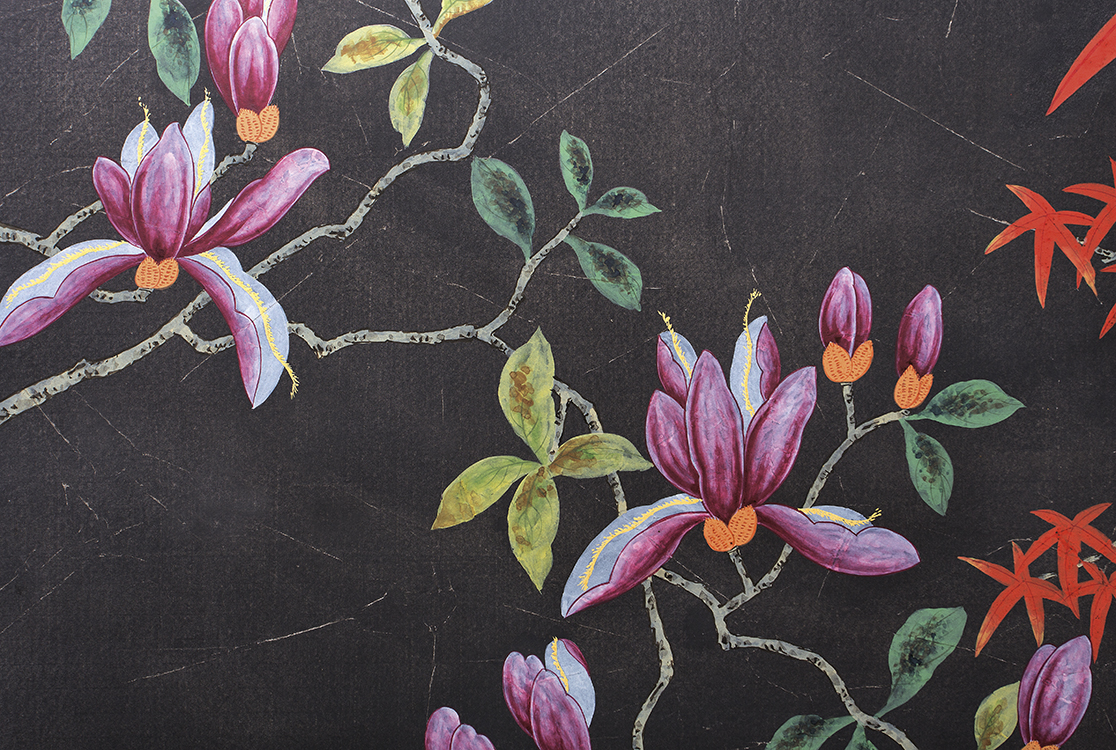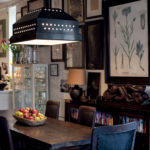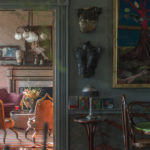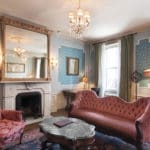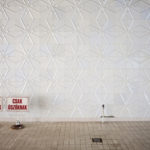by MONIKA NORWID
photography SIMONE STRANO
1.1
Above: The “Summer Night Blossom” design in the original design colors, on black Edo Night Xuan paper.
A wall with flowers on it. Another with scenes of birds in branches. Further down, some sea creatures. To the back, panoramas with people from another (or invented) time holding objects and walking at the foot of a mythical mountain. The chairs carved, painted, gold-leafed, upholstered, cushioned. The tables stacked, strewn, layered, lined, arranged. On the tables, porcelain plates and cups and saucers with budding clusters of more flowers and flocks of more birds.
And in the middle of it all, just barely distinguishable from the riot of artifacts around them, two young women, one basketballer-height, the other a manageable medium, each blond, each graciously but clearly the boss of this walk-in kaleidoscope of worlds within worlds within worlds.
The visual density is disorienting, even distressing. Is this really how the fancy wallpapers of famed luxury brand de Gournay, whose showroom I’m in, are supposed to make you feel? De Gournay, after all, is the holy grail of interior design on many a designer’s mood board—the kind of product whose knockoffs get knocked off, whose name sounds dropped when spoken.
Since 1984, when the company was started by a young accountant trying to restore some antique wallpaper in his family house, it has forged and dominated a niche in the high-end décor market—with spin offs into dinnerware and furniture—by doing the opposite, reverse, and outright sabotage of common business practice. Even today, in a world that is seemingly embracing the concept of counterintuitive entrepreneurship, de Gournay still manages to shock and reinvigorate.
I turn over a saucer to the label side, hoping to get some consumerist bearings, when I hear: “The china is made in China. You know—where china originally came from.” Busted. The tall boss has intuited my reflexive, lazy snobbery with absolute accuracy. If de Gournay is the Chocolate Factory of handmade wallpapers, this woman, I recognize immediately, is my Charlie. She is Gwendolyn Rayner, de Gournay’s New York director. (The other boss, press attaché Laura Cannon, has wisely attachéd herself to Grey’s photo team, who’ve proceeded to manhandle the showroom’s contents into photogenic arrangements for the shoot you see in these pages.)
With pool-blue nails conducting a legion of athletic limbs and blond hair, Gwen looks like she could load a gun with one hand and insert a diamond earring with the other. Though she’s clearly in the middle of a crushing work week (her feet are perpetually pointing back to a desk-like mountain of rolled paper—the take-offs for a myriad current projects), Gwen’s enthusiasm for the subject of her work gets the better of her. Her answers to my half-formed questions wallop out of her compulsively like squash balls. As she talks to me about ingenious techniques and historical references, she begins to pull scrolls of paper from a cabinet to show me, flaring them out with increasing speed and glee.
De Gournay, Gwen explains, was one of the first businesses in the West to take their manufacturing needs to China in the 1980s. But unlike companies today, it didn’t do so because of China’s cheap labor, but, quite to the contrary, because of its priceless artisinal knowledge: to work with the last communities who are still perpetuating the traditions of Chinese wallpaper-making, in the villages of the Guangdong region that has historically been renowned for this art.
Today, “Made in China” implies precisely the opposite of what it meant to Claud Cecil Gurney in 1984, when, after months of wooing the skeptical Communist authorities (even bringing them to England for a visit of his home), his hard-won access into the Asian market brought a trove of ancient knowledge and skill back to the wallpaper industry when he founded de Gournay.
It’s no small irony that when today’s Chinese luxury-hungry elites come to the de Gournay showroom in Shanghai, they too expect the brand to represent a piece of French or English heritage. When told that the work is made in China, it is a kind of double culture shock for them to get over their own Euro-centric snobbery—and then to replace it with the pride that such awareness of their roots must inevitably instill.
“What’s your favorite color,” Gwen volleys at me, more an order than a question, a magician in need of participants. The word “black” pops into my mind. But before I get the courage to actually say it, outnumbered as I am by the most vivid hues, she’s rolling out a design of orchids set into the deepest, almost luminous black I’ve ever seen. I beam a giant smile.
“Black, right? I thought so,” she says, satisfied.
And this, in a nutshell, is the core of de Gournay’s service: connecting its customers not only to the environment around them through the wallpapers, but to their own minds, to the very instincts and sensitivities which make that environmental bond a personal and profound one.
It does so through the process of making the wallpapers with, not just for, their clients—starting with that very scary question: What’s your favorite color?
It’s not about having a million options, it’s about getting to the one that works best. Much like choosing a tattoo for your body, clients who work with Gwen to create a de Gournay panel for their home or business sometimes go through near-nervous breakdowns trying to nail down that singular vision which will encapsulate their identity, and which they will most likely inhabit for the rest of their lives.
“Sometimes when I have to go through the archives, I kind of have a small anxiety attack coming across certain names,” she says, recalling clients or projects that were especially stressful. De Gournay takes its work very personally. In fact, the company often refuses projects. A luxury hotel wanted de Gournay papers made for each of its 500 rooms. “That’s not how we work,” Gwen had to tell the potential client. It would have been a boon for any other company. But de Gournay is not like any other company, exuding singularity not only in what it does but in how it does it. “We like to work on a room-by-room basis.” A regular client wanted something simple, minimal: stripes. Gwen smiled kindly, but with a raised brow. “I told him, ‘You’re at de Gournay and you’re asking for stripes?’” (She did point the gentleman, politely, to a number of other high-quality wallpaper companies that happily do stripes.)
Having said that, de Gournay is currently responsible for a core element in the rebranding of Tiffany’s. The jewelry giant hired architecture firm A. M. Stern and de Gournay to collaborate on a wallpaper for every Tiffany shop worldwide, including its airport shops. The design is based on archival drawings of stained glass windows. De Gournay also reinterprets old classics and chinoiserie favorites to appeal to the growing demand for iconic vintage prints. This season, for example, it created a version of the famous peacock wallpaper that was in Pierre Bergéand Yves Saint Laurent’s dining room in Paris.
If you try to research the history of wallpaper, you’ll find a disturbingly Euro-centric spin on the facts. Wallpaper, it is repeated in a majority of books and wiki pages, began in Europe in the 17th century as the poor man’s tapestry. It’s telling that there’s a bias, if not an outright blind spot, in the West’s narrative of the craft. The economically dominant forces of Europe misused, co-opted and diluted the cultures that they colonized, and wallpaper was no exception.
The fact, however, is that Chinese wallpaper came first. Formed during a groundbreaking surge of innovation and artistry, Chinese wallpapers from the 14th century represent not only the brilliance of the inventors and artists doing the work, but of the culture which made such advances possible.
The Chinese used art as a scientific, spiritual and philosophical practice. They documented the local world around them with the precision of naturalists, working from observations of living flora and fauna, often in the wild (as opposed to later European traditions, which used taxidermied specimens as models). The wallpapers were an encyclopedia come to life on their walls, a kind of IMAX theater of their local environment projected in their homes.
The Chinese believed in Spirit Resonance, the ability of the artists, through intense attention to and affection for their subject matter, to imbue their work with an inherent spiritual power. The space was thus transformed through these papers into an embodiment of the divine in nature.
And, finally, the subject matter in the wallpapers was a commentary on the virtues of a productive, peaceful, healthy society, featuring everything from panoramas of a thriving wildlife (with birds often shown in pairs, representing love and reproduction), to vignettes with figures busy at work creating the very crafts, like ceramics, that generated dignity and joy in people. The walls thus became an inspirational, communal self-portrait of the best aspects of society.
By the time Chinese wallpapers made it to the West, however, they were just another luxury import to keep out the cold and decorate the walls with a new fad: chinoiserie. Lost on the Europeans was the intention, meaning and power. The connection between the inner, domestic world, and the outer, political and environmental worlds, was gone.
De Gournay is changing that. By going back to the artisans in China not just for the product but for the process, the company is at least acknowledging, and perhaps even rehabilitating, the intensity of the art form. For a modern era where everything is considered “wallpaper” —where the world is a mere background to our narcissistic self-absorption, and material goods are just props for our insatiable lifestyles—de Gournay comes as a subversive shock to the senses, pushing our surroundings unapologetically into the foreground.
This effect is achieved through a layering process. The paper itself is layers of different materials: either paper or silk as the paintable surface, then muslin as a middle substrate, and finally canvas as the final backing. The paints, too, are many layers of transparent watercolors—no opaque pigments are used in Chinese wallpaper. And finally, the outlines are fine lines of ink, in some areas “threaded” or repeated so close together as to create the effect of volume but without creating a solid block of ink. (Also, pure black or white ink is never used, as these are not natural colors.) The accumulation of layers allows for two things: dimension and resonance. Dimension is created through gradations of light. That’s how our eyes operate when they see “color,” which is just light playing on our retinas in grades of color waves. Resonance is achieved through the interplay of complimentary colors whose impact on each other makes the images seem to vibrate, or come to life, in the closest and most naturalistic approximation to actually being in nature.
The same fine art techniques, materials, and craftsmanship used to make art were used to make wallpaper. Indeed, wallpapers are considered art even today, and Chinese wallpaper panels are often presented framed. Chinese wallpapers were also painted as panoramas, in panels. Each panel was unique, and numbered for placement.
We are not used to having to collaborate with our environment. De Gournay wallpapers insist on it. You become a part of the setting, and once you accept that you and your environment must share the same visual plane, you begin to enjoy the company—and then, ultimately, to really crave it, because you recognize it as a very primal need: harmony.
Long after my conversation with Gwen was over, I couldn’t leave the showroom. I was smitten and held captive. A vivid blue was telling me to get more exercise. The layers in a feather were rejoicing with me on the subject of love. A curve of peeling bark was asking if I shouldn’t perhaps brush up on my Spanish and travel south this summer. A beige filigreed with gold was telling me to calm down: everything was going to turn out fine as long as I didn’t succumb to distractions.
How Gwen had drawn me in with her passion is a direct extension of how de Gournay wallpapers draw their viewers in. They teach us about a certain approach to our world. An attention to detail. A vulnerability. A focus that calms our minds and liberates our imaginations. They do this with honest, hard work and real, visceral results—through the subtle persuasion of exquisite craftsmanship, which any human eye can recognize, and the fundamental beauty of nature (however abstracted it may be in a given design), which every creature on earth is wired to respond to. These papers don’t just make us feel cool or cozy or happy or alive. They make us feel.

